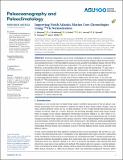Files in this item
Improving North Atlantic marine core chronologies using 230Th-normalization
Item metadata
| dc.contributor.author | Missiaen, Lise | |
| dc.contributor.author | Waelbroeck, C. | |
| dc.contributor.author | Pichat, S. | |
| dc.contributor.author | Jaccard, S. L. | |
| dc.contributor.author | Eynaud, F. | |
| dc.contributor.author | Greenop, Rosanna | |
| dc.contributor.author | Burke, Andrea | |
| dc.date.accessioned | 2019-07-11T10:30:01Z | |
| dc.date.available | 2019-07-11T10:30:01Z | |
| dc.date.issued | 2019-07-10 | |
| dc.identifier | 259194015 | |
| dc.identifier | 0517fb67-31c1-4060-a4fb-f4395e9eee07 | |
| dc.identifier | 85068804920 | |
| dc.identifier | 000481820300002 | |
| dc.identifier.citation | Missiaen , L , Waelbroeck , C , Pichat , S , Jaccard , S L , Eynaud , F , Greenop , R & Burke , A 2019 , ' Improving North Atlantic marine core chronologies using 230 Th-normalization ' , Paleoceanography and Paleoclimatology , vol. 34 . https://doi.org/10.1029/2018PA003444 | en |
| dc.identifier.issn | 0883-8305 | |
| dc.identifier.other | ORCID: /0000-0002-3754-1498/work/64034533 | |
| dc.identifier.uri | https://hdl.handle.net/10023/18078 | |
| dc.description | This is a contribution to ERC project ACCLIMATE; the research leading to these results has received funding from the European Research Council under the European Union’s Seventh Framework Programme (FP7/2007-2013)/ERC grant agreement 339108. SLJ acknowledges funding from the Swiss National Science Foundation (grants PBEZ2-111588 and PP00P2_144811). SP acknowledges the support from the ENS de Lyon for a CRCT (research sabbatical at the LSCE and MPIC). AB and RG were funded by NERC grant NE/M004619/1 awarded to AB. | en |
| dc.description.abstract | Producing independent and accurate chronologies for marine sediments is a prerequisite to understand the sequence of millennial‐scale events and reveal potential temporal offsets between marine and continental records, or between different marine records, possibly from different regions. The last 40 ky is a generally well‐constrained period since radiocarbon (14C) can be used as an absolute dating tool. However, in the northern North Atlantic, calendar ages cannot be directly derived from 14C ages, due to temporal and spatial variations of surface reservoir ages. Alternatively, chronologies can be derived by aligning Greenland ice‐core time‐series with marine surface records. Yet, this approach suffers from the lack of clearly defined climatic events between 14.7 and 23.3 cal ky BP (hereafter ka), a crucial period encompassing Heinrich Stadial 1 (HS1) and the onset of the last deglaciation. In this study i) we assess the benefits of 230Th‐normalization to refine the sedimentation history between surface temperature alignment tie‐points and ii) revisit the chronologies of three North Atlantic marine records. Our study supports the contention that the marked increase in the Greenland Ca2+ record at 17.48 ka ± 0.21 ky (1σ) occurred within dating uncertainty of sea surface temperature cooling in the North Atlantic at the onset of Heinrich Stadial 1. This sharp feature might be useful for future chronostratigraphic alignments to remedy the lack of chronological constraint between 14.7 and 23.3 ka for North Atlantic marine records that are subject to large changes in 14C surface reservoir age. | |
| dc.format.extent | 17 | |
| dc.format.extent | 1824033 | |
| dc.language.iso | eng | |
| dc.relation.ispartof | Paleoceanography and Paleoclimatology | en |
| dc.subject | Th-normalization | en |
| dc.subject | North Atlantic marine chronologies | en |
| dc.subject | GE Environmental Sciences | en |
| dc.subject | DAS | en |
| dc.subject | SDG 14 - Life Below Water | en |
| dc.subject.lcc | GE | en |
| dc.title | Improving North Atlantic marine core chronologies using 230Th-normalization | en |
| dc.type | Journal article | en |
| dc.contributor.sponsor | NERC | en |
| dc.contributor.institution | University of St Andrews. School of Earth & Environmental Sciences | en |
| dc.contributor.institution | University of St Andrews. St Andrews Isotope Geochemistry | en |
| dc.identifier.doi | https://doi.org/10.1029/2018PA003444 | |
| dc.description.status | Peer reviewed | en |
| dc.date.embargoedUntil | 2019-07-10 | |
| dc.identifier.grantnumber | NE/M004619/1 | en |
This item appears in the following Collection(s)
Items in the St Andrews Research Repository are protected by copyright, with all rights reserved, unless otherwise indicated.

